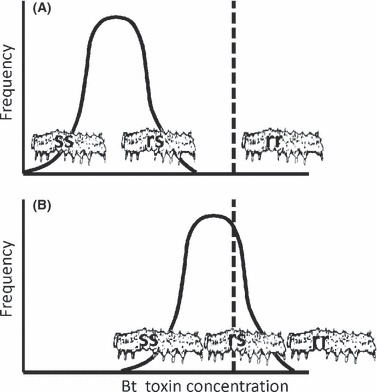Figure 1.

Distribution of insects from unexposed populations for which the given concentration of Bt toxin is the maximum tolerated. The dashed line shows the Bt toxin concentration produced by a Bt crop. The unexposed populations in (A) and (B) are composed almost entirely of susceptible (ss) and heterozygous (rs) individuals, while homozygous resistant (rr) individuals are extremely rare. (A) The insect population is highly susceptible. The toxin concentration in the Bt crop is higher than the concentration that kills virtually all larvae of the unexposed population. Mutations that cause major decreases in susceptibility are needed to boost survival on the Bt crop and thereby confer resistance. Survival is virtually 0% for both ss and rs, which yields recessive inheritance of resistance. (B) The unexposed population is inherently less susceptible and a substantial percentage can survive on the Bt crop. Mutations with small or moderate effects can boost survival on the Bt crop and thus confer resistance. Survival is greater for rs than ss, yielding non-recessive inheritance of resistance.
